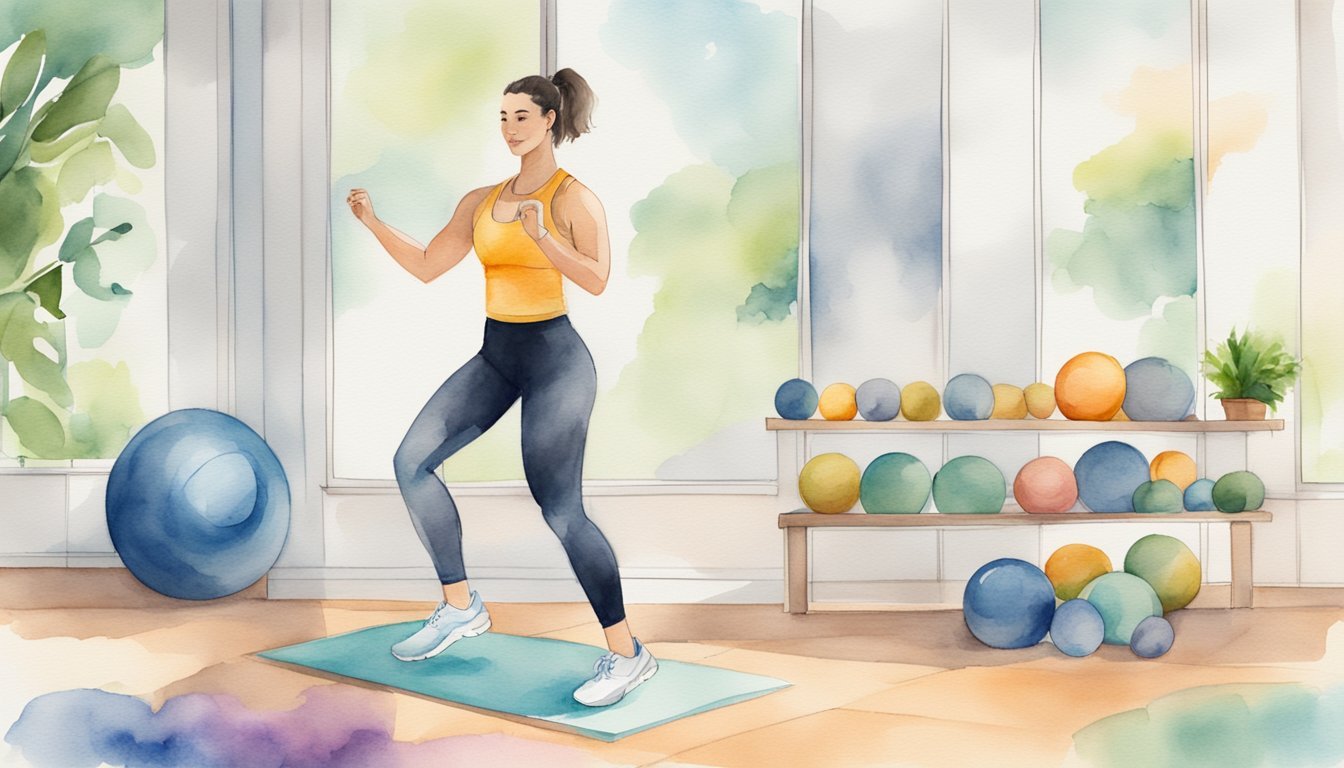Personalized Fitness Plans: Your Perfect Side Hustle

Creating a personalized fitness plan can be one of the most effective ways to reach your health and fitness goals. A personalized fitness plan helps you stay motivated and on track by tailoring workouts to your specific needs and preferences. Whether you’re looking to lose weight, build muscle, or simply maintain a healthy lifestyle, a custom plan can make the process more enjoyable and effective.

Incorporating aspects like flexibility, cardiovascular health, and strength training, you can design a plan that fits seamlessly into your life.
You might consider using an online workout planner that allows you to create workouts based on the equipment you have and your personal preferences.
The idea is to have a plan that evolves with you as your fitness journey progresses.
As you set and reassess your fitness goals, using tools that adapt to your fitness level can make a huge difference.
Sites like Pumpd and BodBot offer features like advanced equipment preferences and personalized nutrition plans to support your efforts.
Making small but consistent adjustments can help keep your routine fresh and challenging.
Key Takeaways
- Personalized fitness plans are tailored to your specific needs.
- Custom plans keep you motivated by evolving with your fitness level.
- Using online tools can enhance your fitness journey.
Understanding Personalized Fitness
Personalized fitness plans cater to your individual health, goals, and preferences.
These plans are different from generic workout programs, which are not tailored to specific needs.
Benefits of Customized Plans
Personalized fitness plans offer several benefits.
First, they focus on your unique goals.
Whether you aim to lose weight, build muscle, or improve endurance, the plan will fit your objective.
These plans consider your current fitness level, health conditions, and preferences, which helps tailor workouts that are both effective and safe.
Another advantage is the flexibility these plans offer.
If you experience changes in your fitness level or lifestyle, the plan can be adjusted accordingly.
This keeps you motivated and ensures continuous progress.
Additionally, personalized plans often provide a mix of exercises you enjoy, making it easier to stick to your routine.
Key Benefits:
- Target specific goals
- Adjust to fitness level and health
- Offer flexibility
- Increase enjoyment and adherence
Personalization vs. Generic Programs
Personalized fitness plans differ significantly from generic programs.
Generic workout programs are one-size-fits-all.
They don’t take into account your personal fitness level or goals.
While they can be a good starting point, they may not be as effective for everyone.
On the other hand, personalized plans are crafted specifically for you.
They include assessments by professionals or the use of fitness apps to gather detailed information about your needs and progress.
This thorough approach helps in creating a routine that maximizes results and minimizes the risk of injury.
Comparative Points:
- Generic Programs:
- One-size-fits-all
- Less effective for individual goals
- Personalized Plans:
- Tailored to your goals
- Professional assessments or apps used
- Maximize results and safety
Setting Fitness Goals
Setting fitness goals is essential for staying motivated and achieving your fitness objectives.
Start by identifying what you want to achieve, such as building muscle or losing weight, then set realistic and achievable goals.
Identifying Your Objectives
The first step in setting fitness goals is knowing what you want to accomplish.
Do you want to lose weight, build muscle, or improve your overall fitness level? Different objectives require different plans.
For instance, if your aim is to build muscle, your plan should include strength training exercises like squats and bench presses.
On the other hand, if you want to lose weight, you might focus on exercises that boost your cardiovascular health and burn calories, such as running or cycling.
Write down your goals and make them specific.
Instead of saying, “I want to get fit,” say, “I want to lose 10 pounds” or “I want to bench press my body weight.” This specific approach helps you measure your progress more accurately and stay focused.
Realistic Goal-Setting
After identifying your objectives, it’s important to set realistic goals.
Aim for milestones that are achievable within a certain time frame.
For example, if you can barely jog a mile, don’t set a marathon as your immediate goal.
Instead, aim to jog for 10 minutes without stopping.
Break your main goal into smaller, more manageable steps.
If you want to build muscle, start with lifting lighter weights and gradually increase the load.
If your goal is to lose weight, start by reducing your calorie intake and increasing your physical activity in small, sustainable steps.
Tracking your progress with a journal or an app can help you stay on course.
Celebrate small victories to keep yourself motivated.
Remember, setting realistic goals is about creating a sustainable plan that leads to long-term success.
By following these tips, you’ll be well on your way to reaching your fitness goals in a way that fits your lifestyle.
Using fitness as a side hustle can help you stay engaged and disciplined, turning your fitness journey into a productive and rewarding pursuit.
Assessing Your Fitness Level
Choosing the right fitness plan means knowing your current fitness level.
Understanding where you start can help you set goals and track your progress.
Initial Assessments and Questionnaires
Before jumping into any workout routine, it’s essential to know where you stand.
Start by assessing your fitness level through simple tests.
You can measure your body composition, test your strength, and evaluate your flexibility.
Use easy-to-find tools like a tape measure for body measurements or a stopwatch for timing your runs.
Online questionnaires can also help identify your fitness habits and goals.
Look for questions about your current exercise routine, daily activity, and any health concerns you might have.
By understanding your baseline, you can better tailor your fitness plan to meet your needs.
This personalized approach ensures that you don’t overdo it and keeps your workout safe and effective.
Tracking Progress and Plateaus
Once you start your fitness plan, tracking your progress is vital.
Keep records of your workouts, noting improvements in strength, endurance, or flexibility.
Using a journal or a fitness app can make this easier.
Pay attention to any plateaus.
These can be moments when you don’t see further improvement despite regular efforts.
This is normal and means your body has adapted to the current routine.
You can break through plateaus by changing exercises, increasing intensity, or adding new challenges.
By monitoring your progress and adjusting your plan as needed, you continue advancing toward your fitness goals.
Regular assessments ensure you stay on track and keep your workouts effective and engaging.
Designing Your Workout Plan
Creating a workout plan that’s right for you involves choosing the right exercises, figuring out the sets and reps, and making sure to include rest and recovery.
This way, you optimize your workouts for strength, flexibility, and mobility.
Exercise Selection
Picking the right exercises is key to any workout routine.
Start with exercises that target the major muscle groups: quads, hamstrings, chest, back, and shoulders.
For strength, include compound exercises like squats, deadlifts, and bench presses.
For flexibility, include stretches and dynamic movements like yoga poses.
Don’t forget mobility exercises like leg swings and arm circles to keep your joints healthy and improve your range of motion.
Remember, the best workout plans mix these different types to create a balanced routine.
Determining Sets and Reps
Sets and reps depend on your goals.
For building strength, aim for 3-5 sets of 4-6 reps with heavy weights.
If you want to improve muscle endurance, go for 2-3 sets of 12-15 reps with lighter weights.
You can also use the progressive overload principle: start with fewer reps and lighter weights, then gradually increase.
For example, you might start by curling a barbell for three sets of 10 reps, then increase to 11 reps and continue from there.
Keep a workout log to track your progress and adjust as needed.
Incorporating Rest and Recovery
Rest and recovery are essential parts of any workout plan.
After intense exercise sessions, your muscles need time to repair and grow stronger.
Aim for at least one rest day per week.
Include short rests between sets.
For strength training, rest for 2-3 minutes between sets.
For endurance workouts, shorter rests of 30-60 seconds are better.
Sleep and nutrition also play a critical role in recovery, so make sure you’re getting enough of both.
Consider using a custom workout generator to tailor your plan to your needs and ensure you include proper rest.
By focusing on these elements, you can design a workout plan that fits your goals and keeps you motivated.
Strength Training Strategies
Focusing on the right strength training strategies can help you build muscle mass and improve your overall fitness.
You’ll learn the importance of both compound and isolation exercises to maximize your gains.
Building Muscle Mass
Building muscle mass requires consistent effort and a well-rounded approach. Strength training is key to increasing muscle size.
First, make sure to lift weights that are challenging.
Aim for 6-12 reps per set with sufficient resistance.
Consistency is critical.
You should be training each major muscle group at least twice a week.
Balance your workouts with both heavy lifting and lighter, higher-rep sets.
Nutrition also plays a vital role.
Ensure you’re consuming enough protein to support muscle growth.
Protein shakes, lean meats, and plant-based proteins are good options.
Compound vs. Isolation Exercises
Compound exercises work multiple muscle groups at once.
Examples include squats, deadlifts, and bench presses.
These moves are efficient for building overall strength and muscle mass.
They also mimic real-life movements, improving functional fitness.
Isolation exercises focus on a single muscle group.
Examples are bicep curls and leg extensions.
These exercises are great for targeting specific areas and addressing muscle imbalances.
However, they should complement, not replace, compound movements.
By blending compound and isolation exercises, you’ll create a robust workout plan.
Use compound exercises as the foundation, and add isolation moves to polish your muscle definition.
This combo ensures you gain strength while also honing in on specific muscle groups you’ve identified for improvement.
Start incorporating these strategies into your routine, and you’ll see growth and strength gains over time.
Cardiovascular Fitness
Cardiovascular fitness is key to improving your endurance and maintaining optimal cardiovascular health.
Embracing the right types of cardio training and smartly balancing them with strength training can significantly enhance your overall fitness journey.
Types of Cardio Training
There are several types of cardio training that you can incorporate into your routine. Steady-state cardio includes activities like jogging, cycling, or swimming at a consistent pace.
This helps improve your endurance over time.
High-Intensity Interval Training (HIIT) involves short bursts of intense exercise followed by rest or low-intensity exercise.
This method is effective for burning calories and boosting your cardiovascular health quickly.
Low-Intensity Steady State (LISS) is another option.
It involves long durations of low-intensity exercises, ideal for those new to cardio workouts or looking for recovery sessions.
Functional workouts such as circuit training can also benefit your heart health.
These focus on movement patterns that mimic daily activities, improving your overall strength and endurance.
Balancing Cardio with Strength Training
While cardio is crucial for heart health and endurance, you shouldn’t overlook strength training.
Combining both can help you build muscle while maintaining cardiovascular fitness.
Plan your week with a mix of cardio and strength exercises.
For example, you might do HIIT on Mondays and Thursdays and incorporate weight training on Tuesdays and Fridays.
Ensure you get enough rest to allow your muscles and cardiovascular system to recover.
Consider active recovery days with light activities like walking or yoga.
Balancing cardio with strength training can also prevent burnout and keep your workouts enjoyable.
By maintaining variety in your fitness routine, you sustain motivation and achieve your fitness goals more effectively.
Nutrition and Fitness
Nutrition and fitness are closely linked.
Your diet can impact muscle gain, weight loss, and workout performance.
Paying attention to macronutrients and staying hydrated are two key aspects.
Macronutrients and Exercise
Your body needs three main macronutrients: proteins, carbohydrates, and fats.
Proteins help in muscle repair and growth.
Good sources of protein include chicken, fish, beans, and tofu.
Carbohydrates provide the energy you need to power through your workouts.
Opt for complex carbs like whole grains, oats, and vegetables for sustained energy.
Fats are also important and should come from healthy sources like avocados, nuts, and olive oil.
Balancing your intake of these nutrients helps improve your exercise performance and aids in muscle recovery.
For those looking at weight loss, adjusting portions and types of macros can make a difference.
For instance, maintaining a higher protein diet can help you feel fuller for longer, reducing the urge to snack.
Hydration and Performance
Staying hydrated is crucial for maintaining your performance during workouts.
Water helps regulate your body temperature and lubricates your joints.
Dehydration can lead to fatigue, dizziness, and decreased coordination.
Aim to drink water throughout the day, not just during your workout.
Sports drinks can be useful if you’re engaging in long, intense exercise sessions, as they provide electrolytes that you lose through sweat.
Coconut water is a natural alternative rich in electrolytes but without added sugars.
Always listen to your body and drink when you’re thirsty.
A good rule of thumb is to drink at least 8 cups of water a day, adjusting for more if you exercise heavily or live in a hot climate.
Making a conscious effort to consume the right nutrients and staying hydrated can greatly enhance your fitness journey.
Fitness Tech and AI

Fitness technology offers a new way to improve your workouts using AI.
With advanced apps and trackers, you can follow customized plans that fit your personal goals and lifestyle.
Workout Apps and Trackers
Many modern fitness apps, like FitnessAI and Athletica, help you track and plan your workouts.
They tailor programs based on your unique fitness level, goals, and history.
These apps provide real-time data on your performance, making it easier to adjust your workout routines.
Using iOS or Android, you can access these tools almost anywhere.
This convenience makes it possible to maintain your fitness routine on the go.
Some apps also offer social features, letting you connect with friends or join virtual fitness communities.
Benefits include:
- Personalized workout plans
- Real-time performance tracking
- Community engagement features
AI in Personalized Training
AI is revolutionizing fitness by creating custom workout plans.
It takes into account your fitness level, workout history, and personal goals to build a plan that adapts as you progress.
For example, Athletica uses AI to create step-by-step training plans and session analyses.
This technology ensures that your workouts remain effective and engaging.
Instead of relying on generic programs, you get a highly tailored routine.
AI also helps with injury prevention by recommending exercises that suit your current condition.
Using AI can make your side hustle as a fitness coach more effective.
You can use AI-driven tools to offer personalized plans to your clients, helping them achieve their goals more efficiently.
Adapting to Lifestyle

Living a busy life doesn’t mean you can’t stay fit.
You can create efficient workout routines that fit into your schedule and incorporate exercise into your daily activities.
Workouts for Busy Schedules
Finding time to exercise can be challenging.
Scheduling short, intense workouts is key. High-intensity interval training (HIIT) is a great option.
These workouts last around 20-30 minutes and can be very effective.
Another idea is using custom workouts designed to maximize your limited time.
You can work with a fitness coach to tailor a plan that fits your lifestyle.
Even busy professionals can find time for a quick workout session by waking up earlier or scheduling workouts during lunch breaks.
Incorporating Exercise into Daily Life
You can blend exercise into your daily routine without needing a gym.
For instance, consider biking or walking to work instead of driving.
Doing chores like gardening or washing your car can also be ways to stay active.
Try taking the stairs instead of the elevator.
Make the most of short breaks by doing push-ups, squats, or stretches.
Small adjustments to your routine can leave a significant impact on your fitness.
Each person’s lifestyle is unique, so your approach should reflect what works best for you.
The main goal is to keep moving, regardless of how packed your day might be.
Special Considerations

When creating personalized fitness plans, it’s important to factor in any unique needs or challenges you may have.
These considerations can range from dealing with injuries to managing chronic conditions.
Dealing with Injuries and Limitations
It’s crucial to adjust your fitness plan if you have injuries or physical limitations.
Listen to your body and avoid exercises that cause pain or discomfort.
For example, if you have a knee injury, substitute high-impact exercises like running with low-impact activities like swimming or cycling. Strength training can also be adapted by focusing on muscles that are not affected by your injury.
Use lighter weights and shorter workout durations to avoid over-stressing the injured area.
Focus on balance and flexibility exercises that can help improve your overall mobility.
These adjustments ensure that you stay active without risking further injury.
Remember to consult with a healthcare professional to tailor these adjustments specifically to your needs.
They can provide exercises that promote recovery and prevent further issues.
Working Out with Chronic Conditions
Working out with chronic conditions like diabetes, arthritis, or asthma requires customized workout plans.
Begin with low-intensity exercises and gradually increase intensity as your body adapts.
For diabetes, cardio exercises like walking or cycling can help manage blood sugar levels effectively.
Pair these with strength training exercises to improve overall fitness.
Arthritis sufferers should focus on low-impact activities like swimming or yoga to reduce joint stress while staying active.
Asthma patients can benefit from controlled breathing exercises combined with moderate activities like walking or gentle stretching.
Always keep medications on hand and exercise in an environment that does not trigger your symptoms.
Consult a healthcare provider to determine the best exercise plan for your specific condition.
They can help you design a routine that considers your limitations while promoting your overall well-being.
Frequently Asked Questions
Creating a personalized fitness plan can be your ticket to achieving your unique health goals.
It’s a flexible and effective way to stay motivated and make the most of your workouts.
How can I tailor a workout plan to my own fitness goals?
To tailor a workout plan, start by identifying your specific goals.
Whether it’s building muscle, losing weight, or improving endurance, your aims should guide your plan.
Consider your current fitness level, preferred activities, and schedule to create something manageable and enjoyable.
Adjust the intensity and variety of exercises to match your progress.
Are there any apps that provide personalized workout routines for free?
Yes, apps like Pumpd offer free custom workout generators.
These tools allow you to input your fitness level and goals to create a workout plan tailored to your needs.
Some premium features might require a subscription, but many essential features are free.
What should I consider when creating a home workout plan without equipment?
When creating a home workout plan without equipment, focus on bodyweight exercises like squats, push-ups, and lunges.
Make sure to include a mix of cardio, strength training, and flexibility exercises.
Adjust the intensity and duration based on your fitness level and progress.
Can I really get a personalized fitness plan without spending any money?
Yes, you can get a personalized fitness plan without spending any money by using free online resources and apps.
Websites like Project Lean Nation offer valuable tips for beginners.
Additionally, many fitness influencers and trainers share free workout plans on social media platforms.
What factors influence the cost of a professionally made workout plan?
The cost of a professionally made workout plan can vary based on the trainer’s qualifications, experience, and the level of personalization.
Other factors include the complexity of the plan, additional services like nutrition guidance, and whether it includes one-on-one coaching sessions.
How often should I update my workout plan to keep it effective and engaging?
You should update your workout plan every 4 to 6 weeks to keep it effective and engaging.
Regular updates prevent plateaus and keep you motivated.
This allows you to adjust exercises, increase difficulty, and incorporate new activities that match your evolving fitness level and goals.

